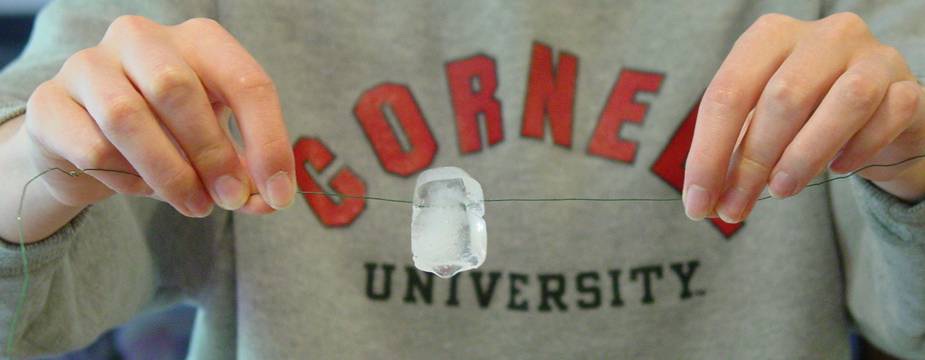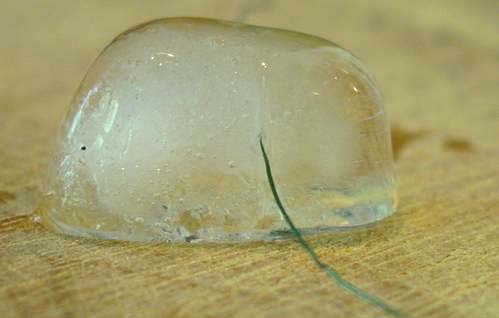





Published on Apr 02, 2024
Matter can exist in one of several different phases: solid, liquid or gas. A change between these phases is caused by a change in temperature or pressure. Water in its solid form is water ice, in its liquid form it is called liquid water, and as a gas it is called water vapor. Some materials, like Nitinol, have more than one solid phase. A change in temperature or pressure will cause them to change from one type of solid to another type of solid, just like a change in temperature will cause water to change from a solid to a liquid or vice versa. In this activity, you will explore the solid to liquid phase change of water caused by a change in pressure.
• Ice cube (and extras)
• Thin wire
• ruler
• Thread (optional)
• Heavy book
• Metal silverware (spoons and forks)
• Space in your refrigerator or freezer (optional)
This ice cube with a wire through the middle was made without drilling a hole through the ice cube. How do you think it was done?

• Loop one end of the wire around half the silverware and twist to secure them together. Do the same with the other end.
• Place the ruler with one end off the edge of a table. Place a heavy book on the other end. If using a plastic ruler, put a piece of cloth or paper on it so it’s not slippery.
• Place the ice cube on the end that is hanging off the edge.
• Lay the wire over the center of the ice cube with the weights hanging down.
• Watch as the wire very slowly “cuts through” the ice cube. After ½ to 1 hour, it should be in the center.

When water is in its solid phase (ice), an increase in pressure will cause the ice to melt, without any change in temperature. The wire with the weights hanging down puts pressure on the ice, which causes it to melt. As the wire moves down through the ice cube, the pressure is released above the wire, and the water can re-freeze above it. Ice skaters may use this property of water. The pressure of a skate blade causes a thin film of ice under the skate to melt, making the ice slippery. When the skate moves, the ice re-freezes behind it. You also use this property of water when you make a snowball. Pressing the snow together causes it to melt a little, and then freeze back together into a ball when you stop squeezing.
• Try doing this in the refrigerator or freezer. Does that change how quickly the wire moves through the ice?
• What if you use other materials? Does it make a difference?
o Try different types or thickness of wire.
o Try using thread instead of wire.
In this activity, you caused water to change phases (from solid to liquid) by putting pressure on it. Water is in different phases depending on temperature, but also depending on pressure. Putting pressure on the ice cube using the weights caused it to change to the liquid phase. Nitinol is special because it has two solid phases. At lower temperatures, it is a soft, bendable solid. At higher temperatures, it is a springy, rigid solid. Which phase it is in depends on temperature. This phase diagram of water shows the temperatures and pressures at which water is a liquid, a solid or a gas. The pressure normally on the ice cube is shown by the line labeled, ”1 atm.” Starting at 1 atm at 0 °C, move straight up. This represents the higher pressure put on the ice cube by the wire.
Will ice stay solid or turn to a liquid? Image courtesy of www.snowcrystals.com But when you take Nitinol in its higher-temperature form, like in Flexon™ eyeglass frames, it is superelastic, or very springy. What makes it superelastic is that when you bend it, the pressure that you’re putting on the metal causes it to change phases back to its softer form. As soon as you release the pressure, it changes back to its more rigid form. Water ice does a similar thing. As the wire puts pressure on the ice cube, it causes some of the ice to change to its liquid phase. As the pressure is released and the wire moves down through the cube, liquid water changes back to its solid phase and re-freezes over the wire.
Nitinol isn’t the only material that has more than one solid phase. Diamond and graphite (pencil lead) are two different phases of carbon. Steel and water ice also have many solid phases with different properties.
• Why You Can’t Have a Snowball Fight on Mars. By Scott A. Sandford http://www.astrosociety.org/pubs/mercury/9801/snowball.html
• Physical Properties of Ice (and lots of fun snowflake info and activities as well) www.snowcrystals.com
• MathMol Hypermedia Textbook – Water and Ice (and information about matter) Grade 3 level: http://www.nyu.edu/pages/mathmol/textbook/whatiswater.html
• Teaching General Chemistry: A Materials Science Companion. Arthur B. Ellis, Margret J. Gesselbracht, Brian J. Johnson, George C. Lisensky and William R. Robinson. Published by the American Chemical Society, 1993.